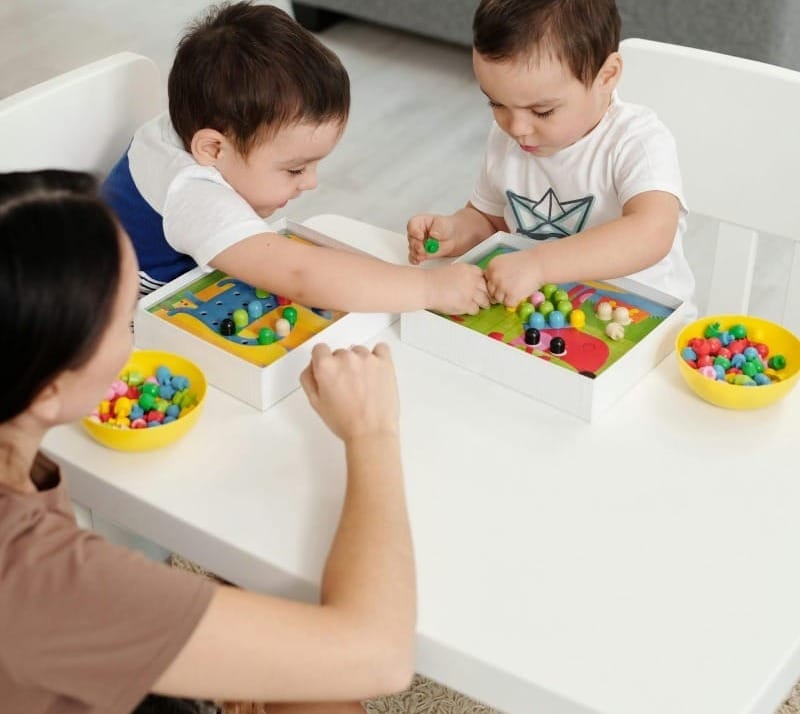Play is Thinking in Action! – Understanding Cognitive Growth in Early Childhood

On many occasions, I have watched preschoolers talk to their toy animals as if they were leading a serious classroom debate. What may look like simple play is, in fact, essential work for children.
Welcome to a new section of our G-Growth journey in the GREATEST parenting roadmap — Cognitive Growth and Development through Play. Over the next few posts, we’ll explore how children’s minds expand as they play, how they think, remember, reason, and make sense of the world, one playful discovery at a time.
The Wonder of the Developing Mind
From the moment a baby begins to reach for a rattle, the brain is buzzing with connections. Neural pathways increase rapidly in early childhood, especially when children are given opportunities to explore and experiment. This “hands-on” experience, whether splashing water, fitting shapes, or pretending to cook, activates multiple areas of the brain at once, strengthening memory, attention, and reasoning.
Developmental psychologist Jean Piaget referred to this stage as “thinking in action.” He believed children construct knowledge through direct experience, learning not by being told, but by doing. When a child tips over a cup of water to see what happens, this action is sowing the first seeds of cause and effect.
Sociocultural theorist Lev Vygotsky added another layer — that play is also deeply social. Through imaginative play and conversation, children begin to use language and interaction to guide their thinking. When two children play “store,” they’re not just pretending to buy apples; they are negotiating, planning, and problem-solving together.
Play is the Brain’s Favorite Workout
A child’s brain doesn’t grow by memorizing flashcards or sitting still. It develops through movement, curiosity, and repetition. Neuroscientists have found that during play, brain regions involved in emotion, planning, and problem-solving blaze like fireworks. These are the signs of developing healthy executive function skills, essential to cognitive development.
Think about a child building a tower with blocks. Each attempt strengthens their ability to plan (“What goes first?”), observe results (“That one fell!”), and try again (“Maybe this block needs to go underneath.”). This trial-and-error block activities create something magical — resilient thinking.
When parents allow space for exploration, without rushing to “fix” things, they give children the gift of discovery. A dropped block becomes a problem to solve, not a mistake to avoid.
Types of Play That Boost Cognitive Growth
Not all play looks the same, but each type nurtures thinking in different ways:
- Exploratory play: Babies and toddlers use their senses to learn by touching, tasting, and testing everything in sight. Dropping spoons, tapping drums, or watching bubbles teaches them cause and effect.
- Constructive play: Preschoolers love to build, create, and arrange. Whether stacking blocks or making sandcastles, they’re learning spatial awareness, sequence, and design.
- Pretend play: When children play “doctor,” “chef,” or “teacher,” they are practicing mental flexibility by imagining different roles, planning scenarios, and understanding others’ perspectives.
- Games with rules: As children grow, simple games like “Simon Says” or “Memory” introduce logic, self-control, and pattern recognition.
Each of these helps children move from concrete exploration toward abstract reasoning, the bridge between “doing” and “thinking.”
From Play to Problem-Solving: A Parent’s Role
Parents often wonder: Should I direct my child’s play? Or just let them lead? The answer lies in balance.
When you follow your child’s lead by joining them at their level, you become a partner in discovery. Ask open-ended questions:
- “I wonder what would happen if…?”
- “How could we make this taller?”
- “Why do you think the water poured out?”
These small prompts and open-ended questions invite reflection without turning their playtime into a boring lesson.
A beautiful real-life moment came from a parent friend of mine who shared her story. Her four-year-old, May, loved pretending to run a “restaurant.” One day, May took her order: “One sandwich and three cups of coffee.” Instead of reminding May (“Children should not drink coffee”). The mom played along and asked, “How many cups will that be for everyone?” May paused, thought, and proudly replied, “Two for you and one for me!” That simple exchange sparked counting, role-play, and confidence, all through play.
When Play Looks Messy (and Why That’s Okay)
Cognitive growth is not tidy. It’s full of spilled paints, toppled towers, and wild imagination. That’s because learning is a process of testing ideas, and children need the freedom to make mistakes safely.
Instead of focusing on the outcome (“What did you make?”), focus on the process (“You really worked hard on that puzzle!”). This helps children internalize the joy of discovery rather than the fear of failure.
When we protect the magic of play, we safeguard the foundation of lifelong learning.
Remember:
Play is not a break from learning; play is learning. Every time a child experiments, pretends, or builds, their mind is expanding in beautiful, invisible ways.
As we move forward in this Mind in Motion series, we’ll look at how language, imagination, and curiosity continue to shape the growing mind, and how you can nurture these moments at home.
So the next time your child turns your living room into a “grocery store” or a classroom, smile and join in. You’re not just playing; you’re witnessing a mind in motion. You are enhancing cognitive development!
References
- Piaget, J. (1952). The Origins of Intelligence in Children. New York: International Universities Press.
- Vygotsky, L. S. (1978). Mind in Society: The Development of Higher Psychological Processes. Harvard University Press.
- Pellegrini, A. D., & Smith, P. K. (1998). The development of play during childhood: Forms and possible functions. Child Psychology Review, 4(3), 260–274.